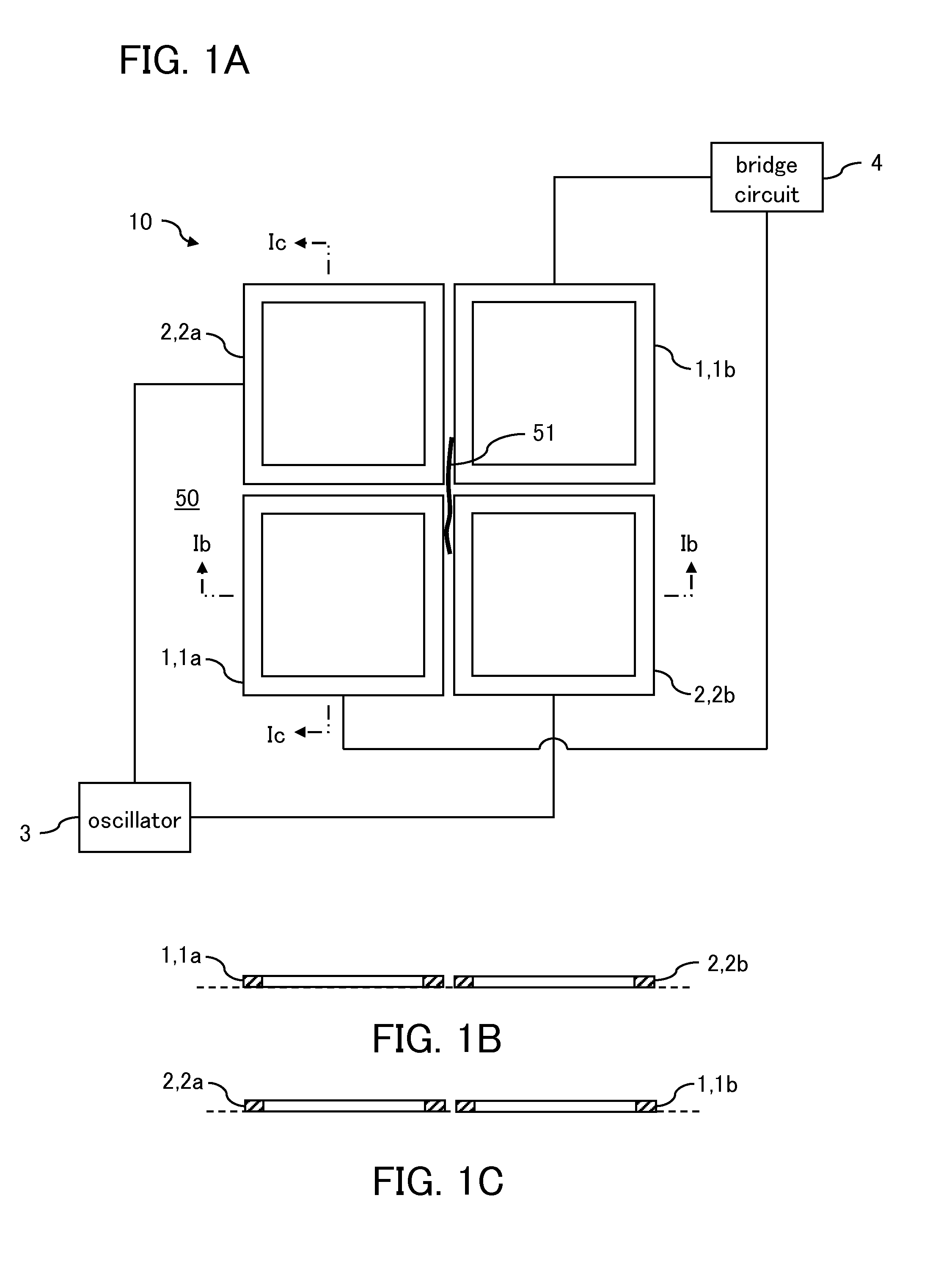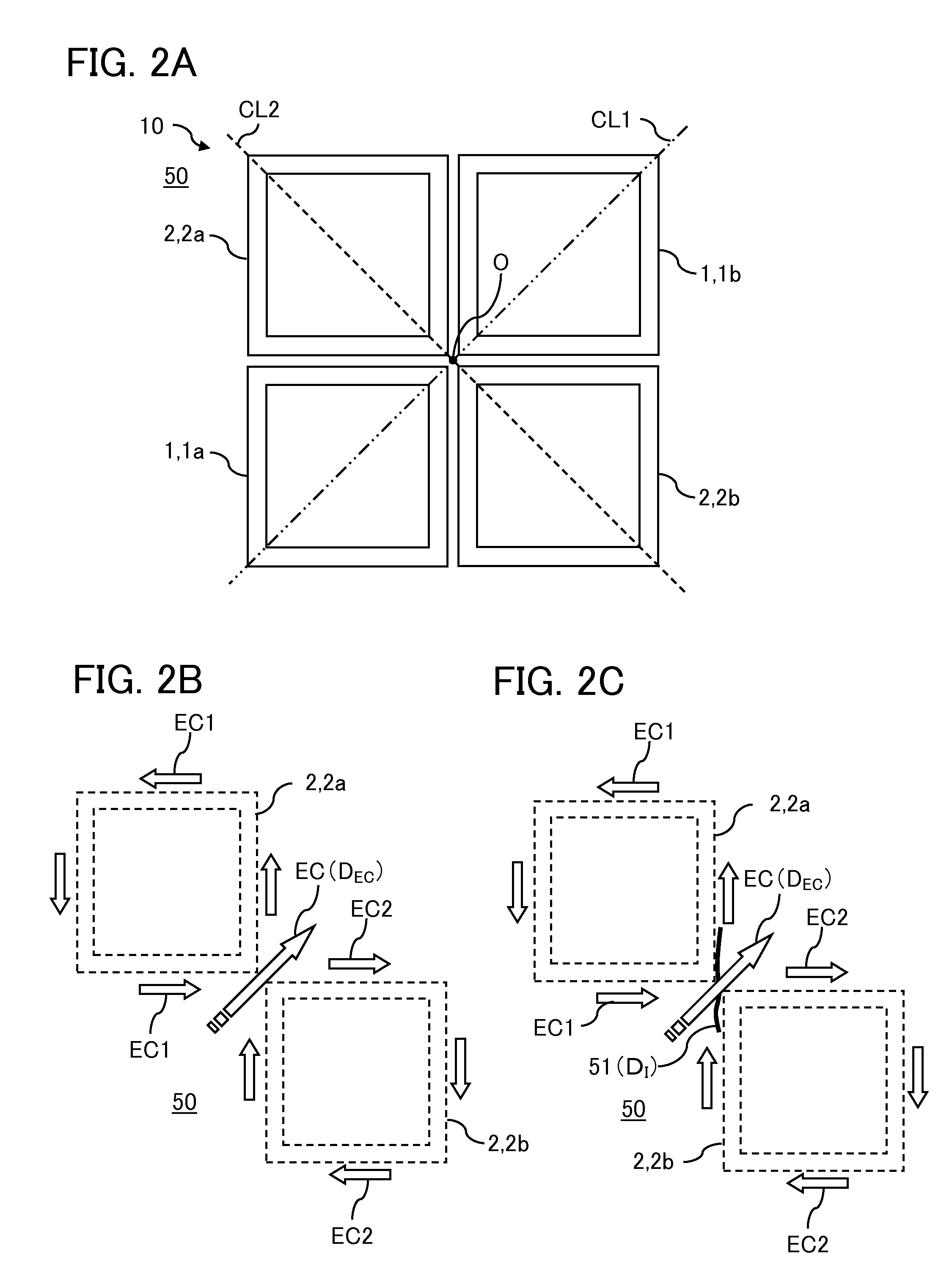Eddy current testing probe and eddy current testing method
a technology of eddy current testing and testing probe, which is applied in the direction of magnetic property measurement, material magnetic variables, instruments, etc., can solve the problem that the probe cannot be used in very narrow places, and achieve the effect of enhancing the resolution of a flaw detection result and small thickness
- Summary
- Abstract
- Description
- Claims
- Application Information
AI Technical Summary
Benefits of technology
Problems solved by technology
Method used
Image
Examples
first embodiment
[0042]The embodiments of the present invention will be described below with reference to the accompanying drawings.
[0043]An eddy current testing probe 10 of the present embodiment is used for detecting a flaw 51 present on a surface of a test object 50 that is positioned thereunder, while moving over the test object 50.
[0044]The configuration of the eddy current testing probe 10 will be described below.
[0045]The eddy current testing probe 10 includes, as shown in FIG. 1, detector coils 1, and exciter coils 2 for generating alternating magnetic fields to generate eddy currents EC near a surface of the test object 50.
[0046]The detector coils 1 include a pair of a first detector coil 1a and a second detector coil 1b. The first detector coil 1a and the second detector coil 1b are differentially connected to each other. For each detector coil 1, a wound coil is used that has a wire wound therearound and is formed in a rectangle shape, and the first detector coil 1a and the second detecto...
second embodiment
[0068]An eddy current testing probe 20 according to a second embodiment relates to a multi coil type eddy current testing probe.
[0069]The eddy current testing probe 20 includes, as shown in FIG. 5, a total of 12 coils C arranged in a matrix pattern on a single plane, i.e., six coils C in a row direction X and two coils C in a column direction Y. Each coil C is made of, like the detector coils 1 and the exciter coils 2 in the first embodiment, a wound coil having a wire wound therearound. However, it is assumed that, in the second embodiment, all of the 12 coils C have an identical electromagnetic property. These coils C are denoted as C11, C12, C13, C14, C15, C16, C21, C22, C23, C24, C25, and C26, as shown in FIG. 5. However, they are collectively denoted as coils C when they do not need to be distinguished from one another.
[0070]Note that, the number of the coils C (i.e., 12) is only an example, and any number of the coils C can be provided in the row direction X and in the column ...
third embodiment
[0086]Next, a third embodiment relates to an eddy current testing probe 30 that performs flaw detection in which a shallow flaw can be detected.
[0087]The present inventors have found that, with the eddy current testing probe 10 according to the first embodiment, the capability of detecting the flaw 51 passing a position of FIG. 1 may be lowered when the flaw 51 is present in a shallow position. Note that the position of FIG. 1 means a boundary portion between the first detector coil 1a and the second exciter coil 2b, and a boundary portion between the first exciter coil 2a and the second detector coil 1b, in the eddy current testing probe 10.
[0088]Thus, the present inventors have conducted studies and found that the eddy current testing probe 30 in which, as shown in FIG. 9, the pair of the first detector coil la and the second exciter coil 2b, and the pair of the first exciter coil 2a and the second detector coil 1b are arranged offset from each other, can detect the flaw 51, which...
PUM
| Property | Measurement | Unit |
|---|---|---|
| eddy current testing | aaaaa | aaaaa |
| magnetic field | aaaaa | aaaaa |
| symmetry | aaaaa | aaaaa |
Abstract
Description
Claims
Application Information
 Login to View More
Login to View More - R&D
- Intellectual Property
- Life Sciences
- Materials
- Tech Scout
- Unparalleled Data Quality
- Higher Quality Content
- 60% Fewer Hallucinations
Browse by: Latest US Patents, China's latest patents, Technical Efficacy Thesaurus, Application Domain, Technology Topic, Popular Technical Reports.
© 2025 PatSnap. All rights reserved.Legal|Privacy policy|Modern Slavery Act Transparency Statement|Sitemap|About US| Contact US: help@patsnap.com



